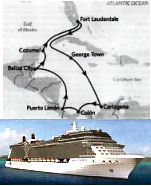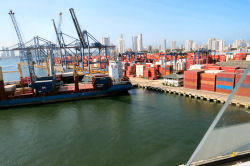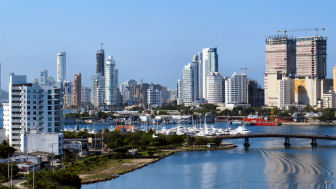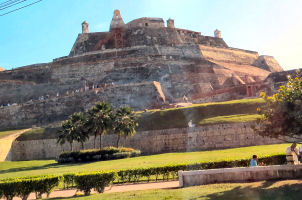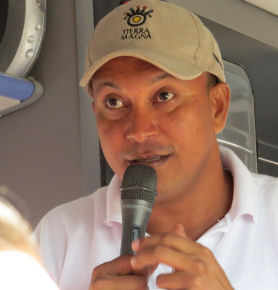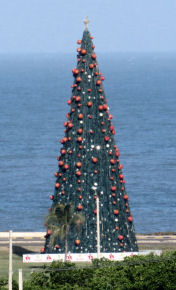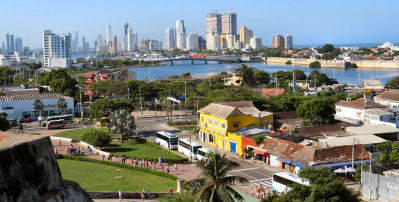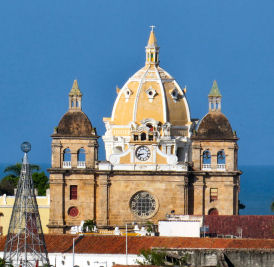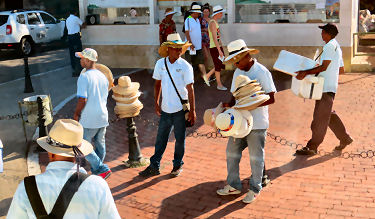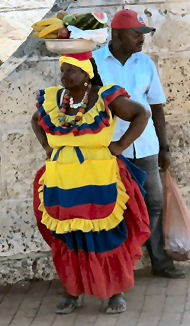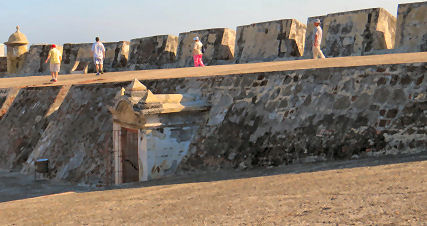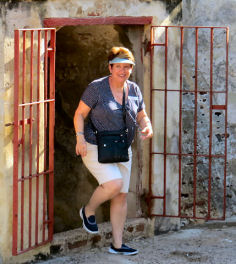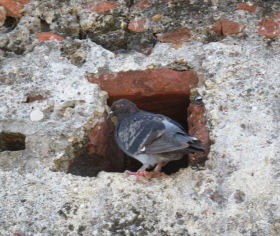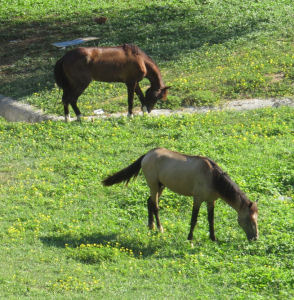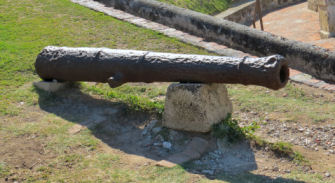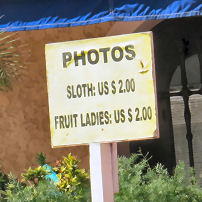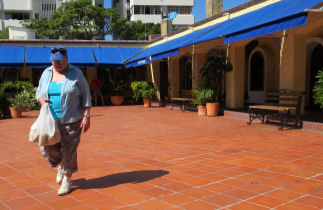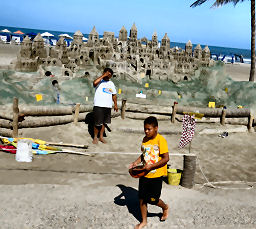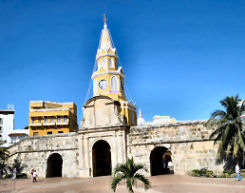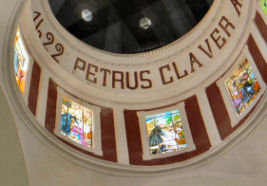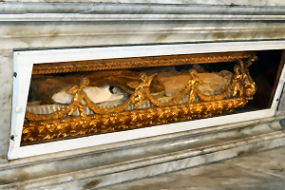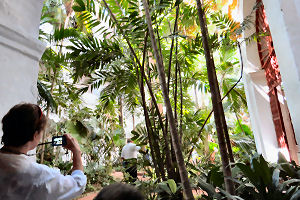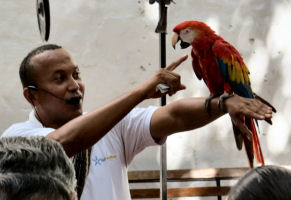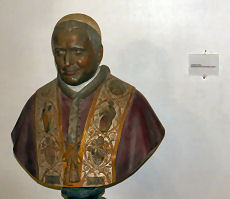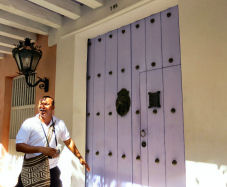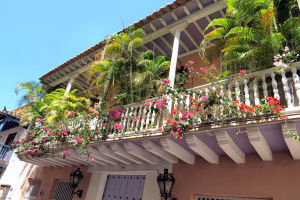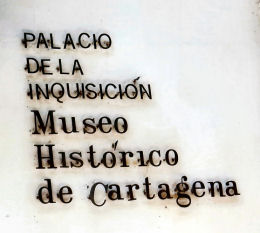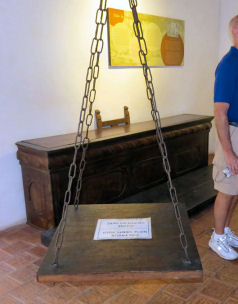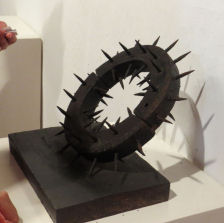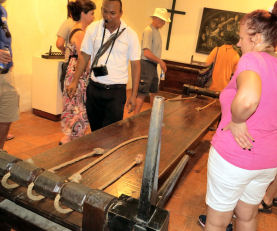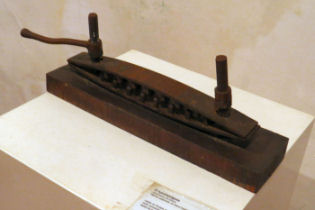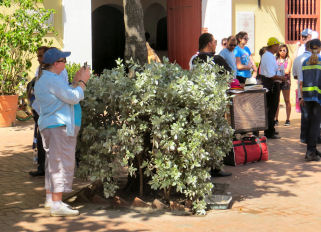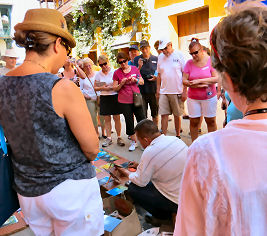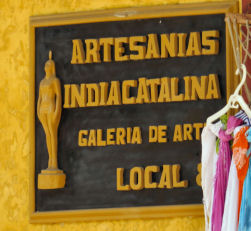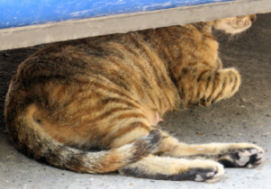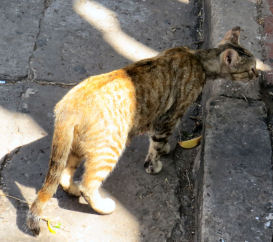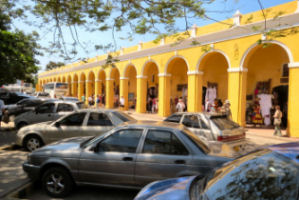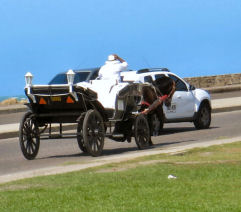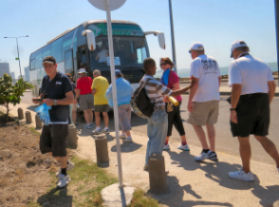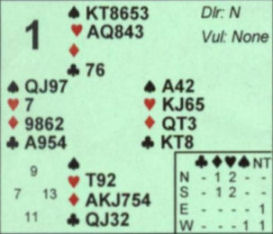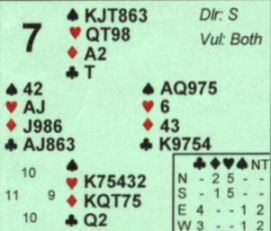By the time that we woke up, the ship was in port in Cartagena de Indias, Colombia. Sue and I were excited about getting to see a new country, but that was not the dominant emotion of the morning. Most of all we – and thousands of other passengers – were relieved that the ship was no longer rocking.
My first priority was to sign on to the Internet and send an e-mail to Frank Evangelista, my bridge partner from the cruise that we took two years earlier. In the message I informed Frank that Sue and I were on another bridge cruise and had run into the Albigs. None of the new e-mails in my Inbox were of much importance.
Sue and I went up to the café for breakfast. We were shocked by both the weather and the condition of the jogging track. The former was quite hot, and the latter was quite wet and much too slick for anyone to run on. The biggest surprise was that there was no wind to speak of. At breakfast I managed to snag the last three pancakes, but they were disappointing; they were almost too cold to eat.
Sue and I both regretted missing Larry's class, but the opportunity to see Cartagena was too much to pass up. The excursion that we had purchased was designed to show us the historical highlights of this famous city. I was most eager to visit the Palace of the Inquisition. In its honor I wore my Monty Python tee shirt that was inscribed "The Spanish Inquisition – expected by no one since 1970."
At about 8:15 we took the elevator down to Deck #3, and eventually we found the gangway. Sue had agreed to meet Marty and Diane Singer on the dock, but there seemed to be no convenient way to do so. There were a many tour officials on the dock, and as soon as we were on dry land they efficiently directed us to bus #3. Diane and Marty were assigned to a different bus, and we only saw them for a few seconds later in the tour.
Our tour guide was a bubbly young man named Daniel. He made us all wear stickers on which the word "Grey"[1] had been written presumably so that he could identify his charges and not lose anyone along the way. A short bus ride brought us to the historic Fortress of San Felipe, the first stop on the tour. On the way Daniel presented a fact-filled lesson on the geography and history of Colombia.- Colombia, with a population of forty-seven million, is the fourth largest country in South America after Brazil, Argentina, and Peru.[2]
- Colombia is bordered by the Caribbean, the Pacific, Brazil, Venezuela, Panama, Ecuador, and Peru. I now think of it as the cork at the top of South America.
- Ecuador and Venezuela were originally part of Gran Colombia. They became separate countries when Simón Bolívar died in 1830.
- Panama seceded in 1903.
- Cartagena is the fifth largest city in Colombia, trailing Bogotá, Medellín, Cali, and Barranquilla.[3]
- Colombia's flag features horizontal strips of yellow, blue, and red. The yellow stripe, which Daniel asserted represented the treasure discovered there by the Spanish, is larger than the other two. Daniel claimed that it was because there was more treasure there. The flags of Ecuador and Venezuela are similar.
- Daniel said that Colombia's chief export was coffee. According to him emeralds and flowers ranked second and third.[4]
- The Fortress of San Felipe was named after King Philip IV of Spain, who ruled Spain at the time of the expansion of the fort in 1657.[5]
- Five U.S. presidents have visited Colombia – Teddy Roosevelt, both Bushes, Clinton (twice), and Obama. Clinton is the most popular in Colombia because of the help that he provided in fighting the drug cartel.
- Although the most popular sport in Colombia is soccer, in Cartagena baseball prevails.
The bus stopped in front of the fort. Sue quickly decided that a climb up to the top with the temperature in the nineties was not for her. She stayed near the bus. I enjoyed the time that we spent inside the fortress, but Sue would have hated it.
Only one or two cannons were on display, but Daniel did a good job of describing where they would be placed and how the fortress was cleverly designed to be almost impossible to attack. Surprisingly, there were only one or two buildings within the fort. The soldiers who manned the guns lived outside the fort and commuted.
The fortress did such a good job of protecting Cartagena that it only fell once, to some French privateers in 1697. The proudest moment for Colombians was the defense of Cartagena in 1741 during the War of Jenkins Ear. Admiral Edward Vernon[6] led a British force that was far larger and more powerful than the Spanish defenders, who were led by Blas de Lezo,[7] a veteran military commander from the Basque region, who, before the battle even began, had already lost one leg, one arm, and one eye. Vernon minted commemorative coins showing the peg-legged Blas surrendering. This was definitely premature. Blas implemented a sophisticated delaying operation in order to avoid a direct confrontation with the British forces that were in every respect superior to his. Eventually the British, whose numbers were decimated by yellow fever, and whose ships were harried by Blas's guerilla tactics, were forced to withdraw in disgrace. Among all the problems that the British faced the most amusing one was the fact that the ladders that their North American troops brought to help them scale the walls were ten feet too short.
The visit to the fortress was followed by a trip to a shopping center. Most of the stores sold emeralds, and I have all that I need. I have no idea what was else for sale. I sat on a bench, worked on my journal, and took a few photos. I tried to take a few surreptitious shots of the guy with the sloth[8] and the two ladies with fruit on their heads, but they were too sly for me. They each wanted $2 per photo.
We then boarded the bus to go to a church dedicated to St. Peter Claver. I had heard of him, but I knew nothing about him. I learned that he was a Jesuit missionary who dedicated his life[9] to helping the slaves who were brought to Cartagena. We were allowed to view his cell, which had a small window that overlooked the plaza in which slaves were sold. According to Daniel as soon Peter heard the rattling of chains from below, he rushed into action to provide food, clothing, medical attention, and spiritual comfort to the slaves who had survived the arduous trip from Africa. He also probably helped more than a few escape.
We also got a short tour of the cloister and a few of the adjacent rooms, including one in which Pope John Paul II had prayed during his visit in 1986. We even got to see an exhibit of some of the St. Peter Claver's bones that are on display in one of the altars.
Peter Claver was beatified by Pope Pius IX in 1851 and canonized by Pope Leo XIII in 1888. When we rushed through the small art museum I spotted a bust of the former but nothing about the latter.
We walked as a group through the old town to the Palace of the Inquisition, which was in operation from 1620 through 1820. There was not too much too see there, but since I was wearing my Spanish Inquisition tee shirt, I felt obligated to photograph and document just about all of the torture devices on exhibit, even though they were only replicas.
Daniel did a very good job of explaining the financial aspect of the Inquisition. Not many people understand that the Dominicans who ran it confiscated all of the property of most of the people who were found guilty, and almost everyone was eventually forced to confess. On the other hand, Daniel did not seem to understand that the Inquisition was not concerned with finding sinners per se. Its targets were limited to heretics[10] and witches.
Our last stop was at a row of twenty or thirty tourist shops that I could not force myself to enter. I sat on a traffic island and took photos of birds and cats. Sue bought some tee shirts.
On the trip back to the pier Daniel gave a quiz. The competition was between the men and the women. It ended in a tie, but only because I was the only one who remembered Blas's name and the reason for the naming of Castillo de San Felipe. Of course, I was also the only person taking notes. I won a postcard, and so did Sue, who volunteered Catalina's name.
We had to go through security to get back onto the ship, but it was not too bad. We went up to our cabin to deposit our gear and then walked over to the café for a late lunch. We both napped through much of the rest of the afternoon. We also downloaded photos and recharged batteries.
Supper was a little weird. The Levins were eating at the Lucases' table, and Maryellen and the Fleers were also absent. So, Sue and I ate alone at an eight-person table. A lady named Sarah invited us to join the group at her table, but Sue (Sue, not I!) declined.
The evening game, in which I played opposite Sue, featured two hands in which we fared much better in the bidding than the play. I was sitting in the East chair. We played hand #1 against the most experienced team. I opened 1♣, South overcalled 1♦, and Sue bid 1♠. North smelled a misfit and opted not to mention the fact that she held eleven cards in the majors. I bid 1NT, and South closed out the bidding with 2♦. He played the hand beautifully and managed to make the contract against the odds. Nevertheless, we got a good score because the opponents failed to find their eight-card heart fit.
On hand #7 we benefitted from our opponents' timid bidding style. South must not have heard of the popular saying "Six and five; come alive." The South hand does not have the two quick tricks that many people expect in an opening hand, but most experts would open it because of its offensive strength. Sue, sitting in the West seat, had just enough to insert a club bid. North overcalled 1♠, which was the last thing that South wanted to hear. With most partners I would have bid 3♣ or even 4♣, but I decided to downgrade Sue's hand and make a simple raise. Besides, I did not want to discourage North from bidding spades again. Incredibly, everyone passed. Our opponents had plenty of opportunities to find their nine-card heart fit, but neither of them saw fit to bid the suit. By the way, it was a good thing that I took the low road. Sue only managed to harvest eight tricks.
We finished tied for second. Afterwards, Sue and I went over the hands and patched up some misunderstandings. Then I went to bed, and Sue went out in search of live music.
[1] I assume that this was his last name, but maybe it was his favorite color.
[2] Since Colombia actually has more inhabitants than both Argentina and Brazil, he must have been talking about total area.
[3] I could name at least one hundred towns in Italy, which has roughly the same number of inhabitants as Colombia, but I could not have named three Colombian cities.
[4] I don't know what made him make that claim. Coal and oil account for over half of Colombia's exports.
[5] Philip was the penultimate Habsburg King. He ruled from 1621 through 1665. His son, Charles II, was sickly and incompetent, but he ruled for a few years. After his death Spain came under the control of the Bourbon family.
